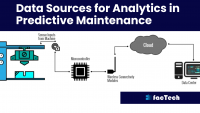Predictive Maintenance with Data Analytics
Predictive maintenance is transforming facilities management by allowing real estate experts to predict equipment requirements and stop problems before they start. Beyond conventional techniques, this proactive approach offers important advantages of predictive maintenance, from increasing the lifetime of assets to avoiding unscheduled outages. Predictive maintenance provides facilities managers with a better, data-driven route to efficiency by allowing them to monitor real-time data. With the help of data analysis, facility managers can improve the operations, reduce downtime, and efficiently maintain the equipment repairs. Factech’s creative facility maintenance management system enables teams to use these insights, simplify maintenance, and protect facility performance for the next generations.

What is Analytics for Predictive Maintenance?
Preventive maintenance Using analytics as an analytical tool will help you to forecast equipment breakdown and stop downtime. It entails real-time observation of important assets and matching this real-time information with past data to spot possible failure points. This lessens maintenance expenses and helps stop breakdowns.
Basic Elements of Predictive Maintenance
These are features fundamental to a good predictive maintenance system:
IoT Framework for Monitoring Conditions
Predictive maintenance depends much on IoT sensors and devices, which help to link the digital world with physical assets. Using IoT sensors in buildings can save maintenance costs by up to 25% and equipment downtime by 70%, boost productivity by 25%, and extend asset lifetime by several years.
IoT devices collect the data and forward it to a centralized system for advanced analysis, while sensors acquire real-time information on several equipment metrics like vibration, temperature, pressure, and acoustics.
Cloud Data Storage and Infrastructure
For evaluating vast amounts of data produced by sensors and IoT devices, cloud platforms provide the required computing capability and storage capacity. They guarantee scalability, therefore allowing the PdM system to grow with the addition of more sensors or equipment.
Human-Machine Interface (HMI)
These user interfaces let maintenance staff engage with the PdM system. Their highly understandable data visualizations, alarms, and maintenance advice show HMIs are absolutely essential to guarantee that system-generated insights are efficiently shared with maintenance-oriented individuals.
Also, read the role of AI in Equipment maintenance.

Data Sources for Analytics in Predictive Maintenance
Failure, Maintenance, and Repair Data
Algorithm training benefits from historical data on failure incidents and maintenance. Though they are infrequent, situations where you swap spare parts or find an anomaly can serve as a proxy for failure events.
Important pieces of information are maintenance data, which includes information on repair activities, equipment condition upon repair, and replacement component needs. Manual data collecting is sadly quite difficult. For simple data collecting, instead take into account employing a computerized maintenance management system (CMMS). Strong reporting capability of CMMS will give you real-time KPIs and metrics, including OEE, MTTR, and MTBF.
Data on In-Use Equipment
Predictive maintenance treats equipment condition as it is used. Real-time sensor data collection lets one find the degradation pattern of a particular asset.
Starting with sensors and other monitoring equipment connected via a CMMS, let the database grow over time. Once the system is trained on this data, it may search the real-time acquired data for trends.
Metadata
One-and-done data type: metadata just needs to be added to the system once. Metadata also comprises technical specs, date of manufacture, and model information. These elements enable the algorithm to spot trends among a smaller range of assets, hence enhancing the accuracy of forecasts.

Predictive Analytics: Advantages for Maintenance Efficiency
Building Sustainable Infrastructure
Every business in the modern world is accountable for making sure facility operations are environmentally friendly and sustainable. One very effective approach to increase facility resource use and efficiency is data analytics. It can find high energy consumption assets and help to lower energy audit expenses.
Raising Operational Excellence
Data analytics offers real-time understanding of how buildings make use of their available resources. These revelations, for example, can inform facility managers on how and what resources are being used, whether there is any waste, how effectively procedures are functioning, and whether staff members are having difficulties maximizing asset use.
Enhanced Asset Management
A facility owns a range of assets, including infrastructure and staff-related ones. A major chore that calls for accuracy is asset management since inefficiency or error could lead to higher costs or negative results.
Lower Expenses
Oftentimes, early identification of issues and timely correction are less costly than waiting to address them later on. This is so true for all kinds of equipment and procedures. Data analysis technologies let one forecast problems and enable proactive maintenance all around the building.
Data analytics helps facility managers find money leaks and congestion in any kind of procedure. This lets them apply ideas meant to cut expenses and waste.
Having Complete View
Usually based on cost per head, facility managers determine the cost of housing staff members within a certain facility. Calculations are erroneous without sufficient measurements and equipment; hence, it is unknown whether facilities are underused or operating at their best.
Data analytics is essential in giving facility managers visibility on facility occupancy, enhancing space utilization, and lowering waste expenses.
Automating Maintenance and FM Processes
Data analytics combined with facility management tools guarantees the facility is effective and flexible across operations. For instance, the Power BI connection of Infraspeak lets you cross-reference data including asset management information, operation data, and work orders, thereby offering the ideal integration to enhance decision-making.

How are Factech’s Connected CMMS Forecasts Issues before they start?
Factech’s connected CMMS helps facility managers to apply predictive analytics and get amazing results. It uses IoT devices to access data from current building automation systems (BAS), therefore giving facilities management teams actionable intelligence to remedy assets before they fail. It linked with all data sources to allow IoT technology to be interoperable and to offer real-time, actionable maintenance knowledge.
Moreover, it helps you to use data-backed judgments to instantly maximize portfolio scale O&M.
The bottom line
Applying Factech’s Connected CMMS to use predictive analytics in facility maintenance is similar to upgrading to a smart assistant for your buildings. This method guarantees the lifetime and efficiency of assets by concentrating on current problems, knowing trends with interoperable data, and preventing any hazards. Contact us to get the free demo.
FAQs
Q.1 Which technology supports predictive maintenance?
To gather, process, and evaluate equipment data, predictive maintenance depends on IoT sensors, machine learning algorithms, artificial intelligence analytics, and cloud computing. Together, these systems track performance, find abnormalities, and project repair requirements.
Q.2 How is AI utilized in predictive maintenance?
AI analyzes historical and real-time equipment data using complex algorithms and machine learning. AI systems can predict failures, optimize maintenance plans, and automate basic diagnostics by spotting trends and abnormalities, decreasing downtime and enhancing asset reliability.
Q.3 What is an example of a predictive maintenance strategy?
One such is tracking temperature, pressure, and power consumption in HVAC systems equipped with IoT sensors. Should sensors identify odd readings, the system can notify the facilities team so they may service the HVAC unit prior to a failure.












